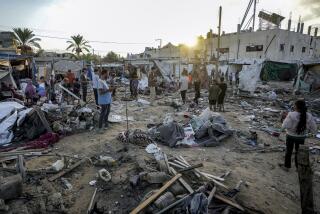Speaking Of: : U.N. Peacekeepers
- Share via
U.N. peacekeeping operations are essentially a holding action, designed to halt or contain the fighting in a conflict while concerted efforts are made to bring about a peace settlement. The U.N. troops, or “blue helmets,” are under the direct supervision of the secretary general and act only in self-defense. The operations, which are not intended to replace the voluntary settlement of disputes, must have broad political consensus among U.N. member states.
THE FACTS * NICKNAME: The name blue helmets comes from the U.S. World War II-surplus helmet liners that were hastily painted sky-blue to give the U.N. forces a distinctive look during their first deployment in 1948.
* OPERATIONS: Of the 26 operations authorized between 1948 and 1992, 12 are still active.
* TROOP DEPLOYMENT: There were 11,498 troops deployed in active missions at the beginning of 1992, a number that is expected to rise to more than 45,000 by the end of the year. In all operations to date, 527,700 troops have been deployed.
* CASUALTIES: As of early September, 816 people had been killed in the service of U.N. peacekeeping operations.
* LONGEST-RUNNING OPERATION: Also the first, the U.N. Truce Supervision Organization continues to operate in what was Palestine. It began in June, 1948.
* SHORTEST OPERATION: The U.N. Observation Group in Lebanon lasted six months, from June, 1959, to December, 1959.
* LARGEST DEPLOYMENTS: The U.N. Operation in the Congo deployed 19,828 peacekeeping troops in July, 1961. The projected force for the current mission in Cambodia is 19,500 troops.
* COST: The estimated cost of the 26 missions to date has surpassed $8 billion with the approximate annual cost of current missions exceeding $2.7 billion. The current secretary general, Boutros Boutros-Ghali, said last week that member nations are behind more than $844 million in peacekeeping contributions, and he proposed a peacekeeping reserve fund of $50 million to meet initial expenses.
* COMPOSITION: Peacekeeping operations have both military and civilian components. The Security Council and the parties concerned have a say in the makeup of military troops. The civilian administrative tasks are handled by U.N. Secretariat staff members, who hire local personnel as needed.
* LEADERSHIP: Peacekeeping missions are usually established by the Security Council and fall under its authority. The secretary general, who reports to the Security Council, appoints a field commander from the leadership provided by countries that contribute troops. Command is periodically rotated.
* MISCELLANY: U.N. peacekeeping forces were awarded the Nobel Peace Prize in 1988 for continued contributions to the promotion and maintenance of world peace. The international force that participated in the Korean War was not a U.N. peacekeeping operation by definition--it was not under U.N. control, it was not based on the consent of the disputing parties, and non-defensive force was used.
WHO PAYS Funds for peacekeeping operations are derived from member countries either through voluntary contributions or by direct assessments approved by the General Assembly. Here are the top 10 contributors and the percentage they provide.
U.S.: 30.4%
Japan: 12.5
Russia: 11.4
Germany: 9.0
France: 7.3
Britain: 6.1
Canada: 3.1
Spain: 2.0
Brazil: 1.6
Australia: 1.5
SENDING IN THE TROOPS
The United Nations has mounted 26 peacekeeping operations since 1948. The deployment of U.N. troops has dramatically increased recently. Thirteen operations were authorized in the first 40 years of the United Nations, while an equal number have been launched in the past four years alone.
Number of operations initiated: 1948-52: 2 * former Palestine, June 1948
* India-Pakistan, January 1949 1953-57: 1 * Egypt, November 1956 1958-62: 3 * Lebanon, June 1959
* Congo, July 1960
* New Guinea, October 1962 1963-67: 4 * Yemen, July 1963
* Cyprus, March 1964
* Dominican Republic, May 1965
* India-Pakistan, September 1965) 1968-72: 0 1973-77: 2 * Israel-Egypt, October 1973
* Syria, June 1974 1978-82: 1 * Lebanon, March 1978 1983-87: 0 1988-92: 13 * Afghanistan-Pakistan, April 1988
* Iran-Iraq, August 1988
* Angola, January 1989
* Namibia, April 1989
* Central America, 1989
* Iraq-Kuwait, April 1991
* Angola, June 1991
* El Salvador, July 1991
* Western Sahara, September 1991
* Cambodia, January 1992
* Cambodia, March 1992
* Yugoslavia, March 1992
* Somalia, April 1992) Sources: The United Nations Department of Public Information, Los Angeles Times reports, Encyclopedia of the United Nations and International Agreements, The Blue Helmets: A Review of UN Peace Keeping, Everyone’s United Nations.
Compiled by Times researcher Kevin H. Fox
More to Read
Sign up for Essential California
The most important California stories and recommendations in your inbox every morning.
You may occasionally receive promotional content from the Los Angeles Times.













